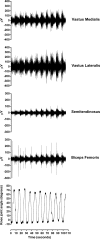Strength Training to Contraction Failure Increases Voluntary Activation of the Quadriceps Muscle Shortly After Total Knee Arthroplasty: A Cross-sectional Study
- PMID: 26339729
- PMCID: PMC4748860
- DOI: 10.1097/PHM.0000000000000361
Strength Training to Contraction Failure Increases Voluntary Activation of the Quadriceps Muscle Shortly After Total Knee Arthroplasty: A Cross-sectional Study
Abstract
Objective: The objective of this study was to investigate voluntary activation of the quadriceps muscle during one set of knee extensions performed until contraction failure in patients shortly after total knee arthroplasty.
Design: This was a cross-sectional study of 24 patients with total knee arthroplasty. One set of knee extensions was performed until contraction failure, using a predetermined 10 repetition maximum loading. In the operated leg, electromyographic (EMG) activity of the lateral and medial vastus, semitendinosus, and biceps femoris muscles was recorded during the set. Muscle activity (%EMGmax) and median power frequency of the EMG power spectrum were calculated for each repetition decile (10%-100% contraction failure).
Results: Muscle activity increased significantly over contractions from a mean of 90.0 and 93.6 %EMGmax (lateral vastus and medial vastus, respectively) at 10% contraction failure to 99.3 and 105.5 %EMGmax at 100% contraction failure (P = 0.009 and 0.004). Median power frequency decreased significantly over contractions from a mean of 66.8 and 64.2 Hz (lateral vastus and medial vastus, respectively) at 10% contraction failure to 59.9 and 60.1 Hz at 100% contraction failure (P = 0.0006 and 0.0187).
Conclusion: In patients shortly after total knee arthroplasty, 10 repetition maximum-loaded knee extensions performed in one set until contraction failure increases voluntary activation of the quadriceps muscle during the set.
Clinical trials: Gov-identifier: NCT01713140 to the abstract to increase trial transparency.
Figures





Similar articles
-
Neuromuscular fatigue to power loading using a weight-stack device fitted with or without additional rubber band resistance.J Strength Cond Res. 2014 Jul;28(7):1802-11. doi: 10.1519/JSC.0000000000000346. J Strength Cond Res. 2014. PMID: 24345972
-
Quadriceps femoris electromyogram during concentric, isometric and eccentric phases of fatiguing dynamic knee extensions.J Biomech. 2006;39(2):246-54. doi: 10.1016/j.jbiomech.2004.11.023. J Biomech. 2006. PMID: 16321626 Clinical Trial.
-
Acute effects of exercise under different levels of blood-flow restriction on muscle activation and fatigue.Eur J Appl Physiol. 2016 May;116(5):985-95. doi: 10.1007/s00421-016-3359-1. Epub 2016 Mar 26. Eur J Appl Physiol. 2016. PMID: 27017495
-
One-repetition maximum can be estimated with a handheld dynamometer and circumference in community-dwelling older adults.J Phys Ther Sci. 2020 Oct;32(10):669-673. doi: 10.1589/jpts.32.669. Epub 2020 Oct 3. J Phys Ther Sci. 2020. PMID: 33132528 Free PMC article. Review.
-
Midsubstance Vastus Lateralis Tear in the Young Athlete: Case Report and a Review of the Literature.Clin J Sport Med. 2023 May 1;33(3):280-282. doi: 10.1097/JSM.0000000000001099. Epub 2022 Nov 22. Clin J Sport Med. 2023. PMID: 36730292 Review.
Cited by
-
Safety, Fear and Neuromuscular Responses after a Resisted Knee Extension Performed to Failure in Patients with Severe Haemophilia.J Clin Med. 2021 Jun 11;10(12):2587. doi: 10.3390/jcm10122587. J Clin Med. 2021. PMID: 34208148 Free PMC article.
-
The role of electromyography in postoperative total knee arthroplasty: A systematic review.J Orthop. 2025 May 10;65:216-226. doi: 10.1016/j.jor.2025.05.007. eCollection 2025 Jul. J Orthop. 2025. PMID: 40487332
-
Blood flow restriction added to usual care exercise in patients with early weight bearing restrictions after cartilage or meniscus repair in the knee joint: a feasibility study.J Exp Orthop. 2022 Oct 4;9(1):101. doi: 10.1186/s40634-022-00533-4. J Exp Orthop. 2022. PMID: 36192606 Free PMC article.
-
The past and future of peri-operative interventions to reduce arthrogenic quadriceps muscle inhibition after total knee arthroplasty: A narrative review.Osteoarthr Cartil Open. 2023 Dec 21;6(1):100429. doi: 10.1016/j.ocarto.2023.100429. eCollection 2024 Mar. Osteoarthr Cartil Open. 2023. PMID: 38304413 Free PMC article. Review.
References
-
- Kehlet H: Fast-track hip and knee arthroplasty. Lancet 2013; 381: 1600– 2 - PubMed
-
- Holm B, Kristensen MT, Bencke J, et al. Loss of knee-extension strength is related to knee swelling after total knee arthroplasty. Arch Phys Med Rehabil 2010; 91: 1770– 6 - PubMed
-
- Meier W, Mizner RL, Marcus RL, et al. Total knee arthroplasty: Muscle impairments, functional limitations, and recommended rehabilitation approaches. J Orthop Sports Phys Ther 2008; 38: 246– 56 - PubMed
-
- Jakobsen TL, Kehlet H, Husted H, et al. Early progressive strength training to enhance recovery after fast-track total knee arthroplasty: A randomized controlled trial. Arthritis Care Res (Hoboken) 2014; 66: 1856– 66 - PubMed
-
- Aalund PK, Larsen K, Hansen TB, et al. Normalized knee-extension strength or leg-press power after fast-track total knee arthroplasty: Which measure is most closely associated with performance-based and self-reported function? Arch Phys Med Rehabil 2013; 94: 384– 90 - PubMed
MeSH terms
Associated data
LinkOut - more resources
Full Text Sources
Other Literature Sources
Medical

